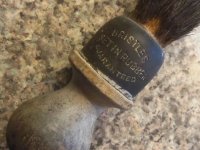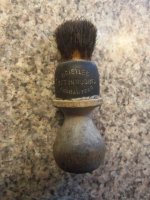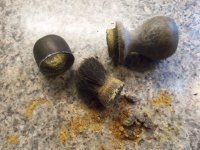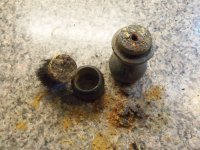The Shaving Cadre
You are using an out of date browser. It may not display this or other websites correctly.
You should upgrade or use an alternative browser.
You should upgrade or use an alternative browser.
Set in Rubber? Why was that important?
- Thread starter Pelagic
- Start date
TobyC
"I shaved a Tribble once..."
I could write pages of info, but no one would want that!On many vintage brushes you see the words printed “set in rubber”. Why was that important or even needed? Was it before they had epoxies to use?
Early brushes of all kinds had many different ways of holding some sort of bristles on the end of a handle. They could be tied, wrapped with twine or wire, or glued or plastered. Andrew Albright patented several designs of brushes and machinery for making brushes and a "Bristle cementing machine" and assigns the to the Rubber and Celluloid Harness Trimming Company, which was his company. They manufactured rubber coated harness trimmings, this was before the Rubberset company existed. Having the bristles firmly cemented so they couldn't be pulled out was a monumental improvement over most of the brushes of the day.
"The brush division of the Rubber & Celluloid Harness Trimmings Company didn't have it's own name. There was a contest with the employees in the company to pick the best name and "Rubberset Company" was chosen. Andrew Jr. decided to focus on growing this arm of the company and began an extensive and expensive advertising campaign. The first use of the name "Rubberset" was on May 15, 1905, just two months after Andrew Sr's passing.
The cement isn't rubber, it's a rock hard glue, "Set In Rubber" was just a sales and advertising thing. It was so successful that other brushmakers started putting that on their brushes too.
It was mostly just a sales slogan, but they made better than average brushes also.
Well then...I learned something today! Thank you Mr. C called Toby!I could write pages of info, but no one would want that!
Early brushes of all kinds had many different ways of holding some sort of bristles on the end of a handle. They could be tied, wrapped with twine or wire, or glued or plastered. Andrew Albright patented several designs of brushes and machinery for making brushes and a "Bristle cementing machine" and assigns the to the Rubber and Celluloid Harness Trimming Company, which was his company. They manufactured rubber coated harness trimmings, this was before the Rubberset company existed. Having the bristles firmly cemented so they couldn't be pulled out was a monumental improvement over most of the brushes of the day.
"The brush division of the Rubber & Celluloid Harness Trimmings Company didn't have it's own name. There was a contest with the employees in the company to pick the best name and "Rubberset Company" was chosen. Andrew Jr. decided to focus on growing this arm of the company and began an extensive and expensive advertising campaign. The first use of the name "Rubberset" was on May 15, 1905, just two months after Andrew Sr's passing.
The cement isn't rubber, it's a rock hard glue, "Set In Rubber" was just a sales and advertising thing. It was so successful that other brushmakers started putting that on their brushes too.
It was mostly just a sales slogan, but they made better than average brushes also.
TobyC
"I shaved a Tribble once..."
You're more than welcome my friend!Well then...I learned something today! Thank you Mr. C called Toby!
TobyC
"I shaved a Tribble once..."
You're welcome!Thanks for the response!!
TobyC
"I shaved a Tribble once..."
Nope.So did they use rubber all all in the Rubberset?
TobyC
"I shaved a Tribble once..."
| 02/04/1913 | Ernest Miltner of Newark, NJ received patent #1,052,081 for "Manufacture of Handles of Plastic Material" and assigns it to the Rubber and Celluloid Harness Trimming Company. | ||
| 02/04/1913 | Ernest Miltner of Newark, NJ received patent #1,052,082 for "Apparatus for the Manufacture of Celluloid Handles" and assigns it to the Rubber and Celluloid Harness Trimming Company. |
TobyC
"I shaved a Tribble once..."
| Nov 1915 | Rubberset wins court case limiting the competition from using "Set in Rubber" without the full name of the manufacturer. Case was against F.W. DeVoe and C.T. Reynolds Co. |
Others were using "Made In Rubber" on their brushes without a brand name to mimic Rubberset.
TobyC
"I shaved a Tribble once..."
They were taking advantage of the Rubberset reputation and advertising.
Nov 1915 Rubberset wins court case limiting the competition from using "Set in Rubber" without the full name of the manufacturer. Case was against F.W. DeVoe and C.T. Reynolds Co.
Others were using "Made In Rubber" on their brushes without a brand name to mimic Rubberset.
This is a good example, it's not a bad brush, it was just a sneaky business practice.


The glue looks exactly like the stuff Rubberset used, there's nothing "rubber" about it.


The cement isn't rubber, it's a rock hard glue, "Set In Rubber" was just a sales and advertising thing.
So did they use rubber all all in the Rubberset?
LIES, It's all LIES!!!Nope.
TobyC
"I shaved a Tribble once..."
Marketing slogans 101.LIES, It's all LIES!!!

